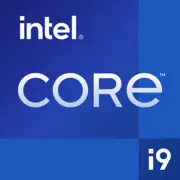Intel Core i9-13900KS

Intel Core i9-13900KS: Potenza per appassionati e professionisti
Marzo 2025
Caratteristiche principali: Architettura Raptor Lake e non solo
Il processore Intel Core i9-13900KS, lanciato alla fine del 2022, rimane una soluzione attuale per utenti esigenti anche nel 2025. La sua architettura Raptor Lake è un'evoluzione dell'approccio ibrido di Intel, che combina Performance-cores (P-cores) e Efficient-cores (E-cores).
- 24 core (8 P-cores + 16 E-cores) e 32 thread: i P-cores funzionano a una frequenza fino a 6.0 GHz in modalità Turbo Boost Max 3.0, garantendo prestazioni monovena record. Gli E-cores (fino a 4.3 GHz) gestiscono i compiti in background.
- Processo tecnologico Intel 7 (10 nm Enhanced SuperFin) ottimizzato per bilanciare efficienza energetica e potenza.
- 36 MB di cache L3 accelera l'elaborazione dei dati nei giochi e nelle applicazioni professionali.
- TDP 150 W (consumo reale fino a 300 W sotto carico massimo!).
- Intel UHD Graphics 770: grafica integrata per compiti di base, ma per giochi o rendering è necessaria una scheda grafica dedicata.
Geekbench 6 conferma la leadership:
- 3100 punti (Single-Core): il miglior risultato tra le CPU desktop al momento del lancio.
- 21795 punti (Multi-Core): competizione con i top di gamma HEDT.
Caratteristiche chiave:
- Supporto per PCIe 5.0 (fino a 16 linee) e DDR5-5600.
- Tecnologie Thermal Velocity Boost e Adaptive Boost per overclock automatico.
- Compatibilità con Windows 11 e ottimizzazione per core ibridi.
Schede madri compatibili: Scelta del socket e del chipset
Il processore utilizza il socket LGA 1700, compatibile con i chipset Z790, H770, B760 e H710.
- Z790: scelta top per appassionati:
- Overclock dei P-cores e E-cores.
- Supporto PCIe 5.0 per schede grafiche e NVMe.
- Esempi di schede: ASUS ROG Maximus Z790 Hero ($599), MSI MPG Z790 Carbon WiFi ($479).
- B760: ottimale per la maggior parte degli utenti:
- Supporto base per l'overclock (solo P-cores).
- Prezzi a partire da $200 (esempio: Gigabyte B760 AORUS Elite AX).
Importante:
- Le schede madri con DDR4 sono più economiche, ma limitano la velocità della memoria.
- Per PCIe 5.0, scegliere modelli con VRM rinforzati e raffreddamento (importante se assemblati con RTX 5090 o GPU simili).
Supporto della memoria: DDR4 vs DDR5
L'i9-13900KS funziona con DDR5-5600 e DDR4-3200.
- DDR5 (raccomandato):
- Larghezza di banda fino a 90 GB/s (rispetto ai 50 GB/s di DDR4).
- Migliori prestazioni nei giochi (aumento fino al 15% in 4K) e nel rendering.
- Contro: prezzo elevato (32 GB DDR5-6000 — $150).
- DDR4 (opzione economica):
- Adatto per l'upgrade di sistemi più vecchi.
- Esempio: 32 GB DDR4-3600 — $80.
Consiglio: Per i giochi, la combinazione di DDR5 + GPU NVIDIA/AMD di ultima generazione offrirà il massimo FPS.
Alimentatore: Come non stressare il sistema
Con un TDP di 150 W e un consumo massimo fino a 300 W (in stress test), i requisiti per l'alimentatore sono rigorosi:
- Minimo 850 W per un sistema con RTX 4080/4090.
- Consigliato 1000–1200 W con certificazione 80 Plus Gold/Platinum (esempio: Corsair RM1000x — $199).
- Utilizzare cavi PCIe 5.0 12VHPWR per le schede grafiche moderne.
Esperienza reale: Gli utenti con alimentatori da 750 W segnalano riavvii quando il carico su CPU e GPU è simultaneo.
Pro e contro: Vale la pena considerarlo?
Pro:
- Miglior prestazione monovena (giochi, Photoshop).
- Supporto DDR4/DDR5 — flessibilità nell'assemblaggio.
- 32 thread per il rendering (Blender, Cinema 4D).
Contro:
- Riscaldamento elevato (richiesta di un sistema di raffreddamento a liquido, es. NZXT Kraken X73 — $249).
- Prezzo: $700–800 (nuovo) nel 2025.
- AMD Ryzen 9 7950X3D è più efficace in compiti multi-thread.
Scenari d'uso: Gioco, lavoro, creatività
- Giochi:
- Cyberpunk 2077 (4K, Ultra) — 120+ FPS con RTX 4090.
- CS2 (1080p) — 600+ FPS grazie alle alte frequenze.
- Compiti di lavoro:
- Rendering in Blender (scena BMW) — 2.5 minuti contro 3.1 per Ryzen 9 7950X.
- Codifica video in Premiere Pro — accelerazione del 18% grazie a Quick Sync.
- Multimedia:
- Streaming in OBS senza perdita di FPS (carico sugli E-cores).
Confronto con i concorrenti: AMD vs Intel
- AMD Ryzen 9 7950X3D ($750):
- Migliore nei giochi grazie alla cache 3D V-Cache (aumento fino al 10% in 1080p).
- Più efficiente dal punto di vista energetico (TDP 170 W).
- Inferiore in compiti monovena (Geekbench 6 Single-Core — 2900).
- Intel Core i9-14900K ($650):
- Aumento insignificante delle prestazioni (5–7%).
- Stesso socket LGA 1700, ma prezzo più elevato per l'upgrade.
Consigli pratici per l'assemblaggio
1. Raffreddamento:
- Necessaria un'unità di raffreddamento a liquido da 360 mm o un dissipatore d'aria di alta gamma (Noctua NH-D15).
- Configurare le curve delle ventole nel BIOS per bilanciare rumore e temperatura.
2. Case:
- Minimo 3 ventole per l'ingresso (esempio: Lian Li Lancool III — $169).
3. Archiviazione:
- SSD PCIe 5.0 (Samsung 990 Pro — $200 per 2 TB) per la massima velocità.
4. Overclock:
- I P-cores funzionano stabilmente a 5.8–6.0 GHz con tensione di 1.35 V.
Conclusione: A chi si adatta l'i9-13900KS?
Questo processore è la scelta per:
- Giocatori, desiderosi del massimo FPS in 1080p/1440p.
- Professionisti, che lavorano con 3D, video e streaming.
- Appassionati, disposti a investire in raffreddamento e alimentatori.
Alternative:
- Per risparmiare energia — Ryzen 9 7950X3D.
- Per un'assemblaggio economico — Intel Core i7-14700K.
Nel 2025, l'i9-13900KS rimane attuale grazie al suo equilibrio unico tra prezzo e potenza. È consigliato se non si è disposti a pagare per i modelli più recenti, ma si desidera prestazioni di alto livello.
Di base
Specifiche della CPU
Specifiche della memoria
Specifiche della GPU
Varie
Classifiche
Rispetto ad altre CPU
Condividi sui social media
Oppure linkaci
<a href="https://cputronic.com/it/cpu/intel-core-i9-13900ks" target="_blank">Intel Core i9-13900KS</a>